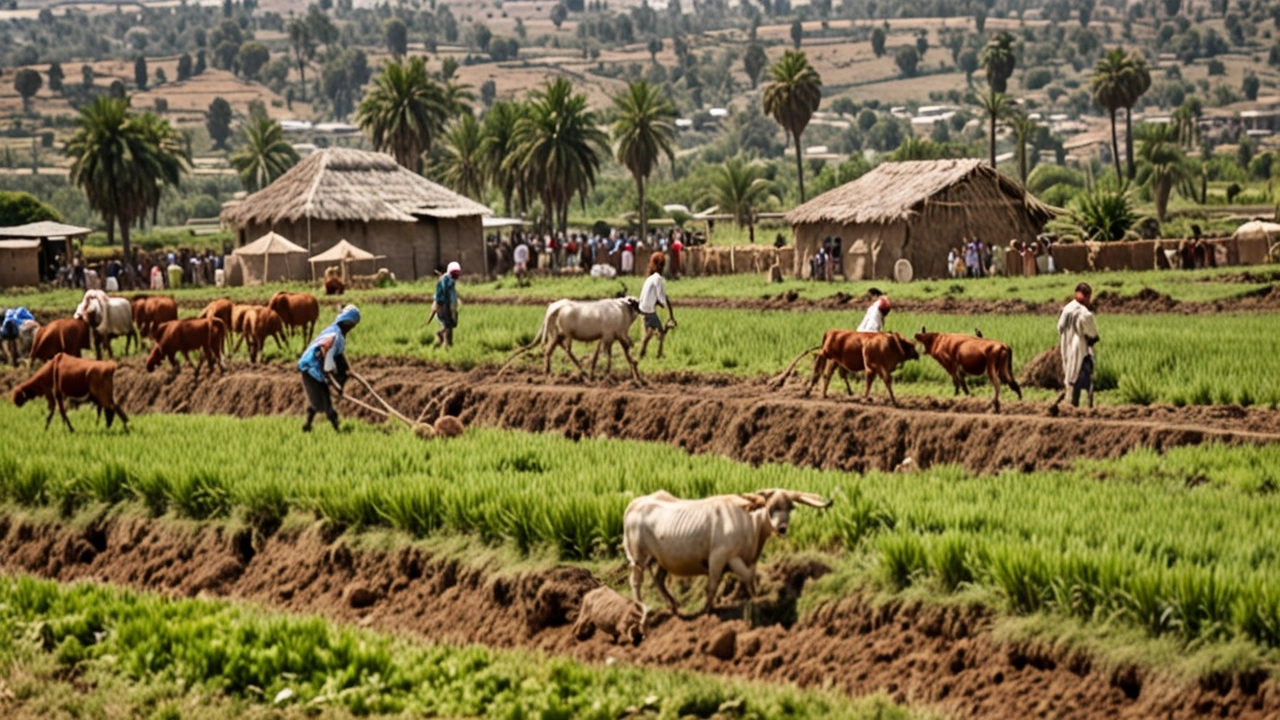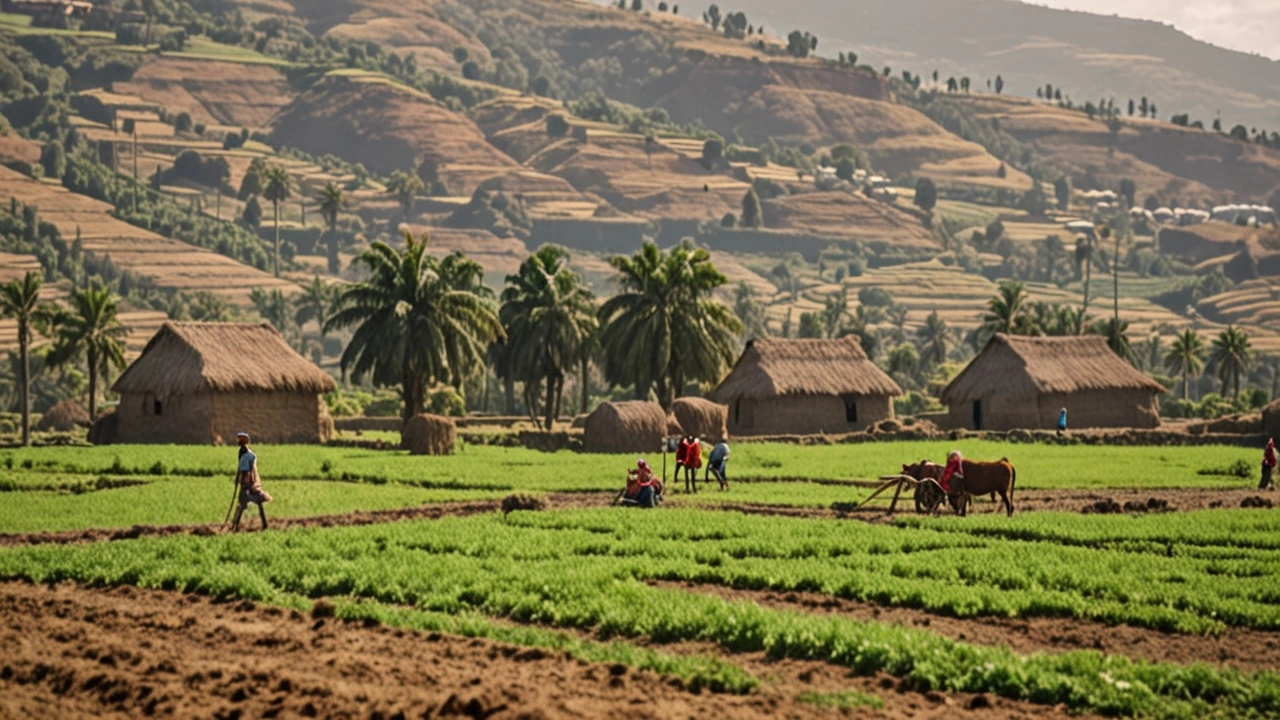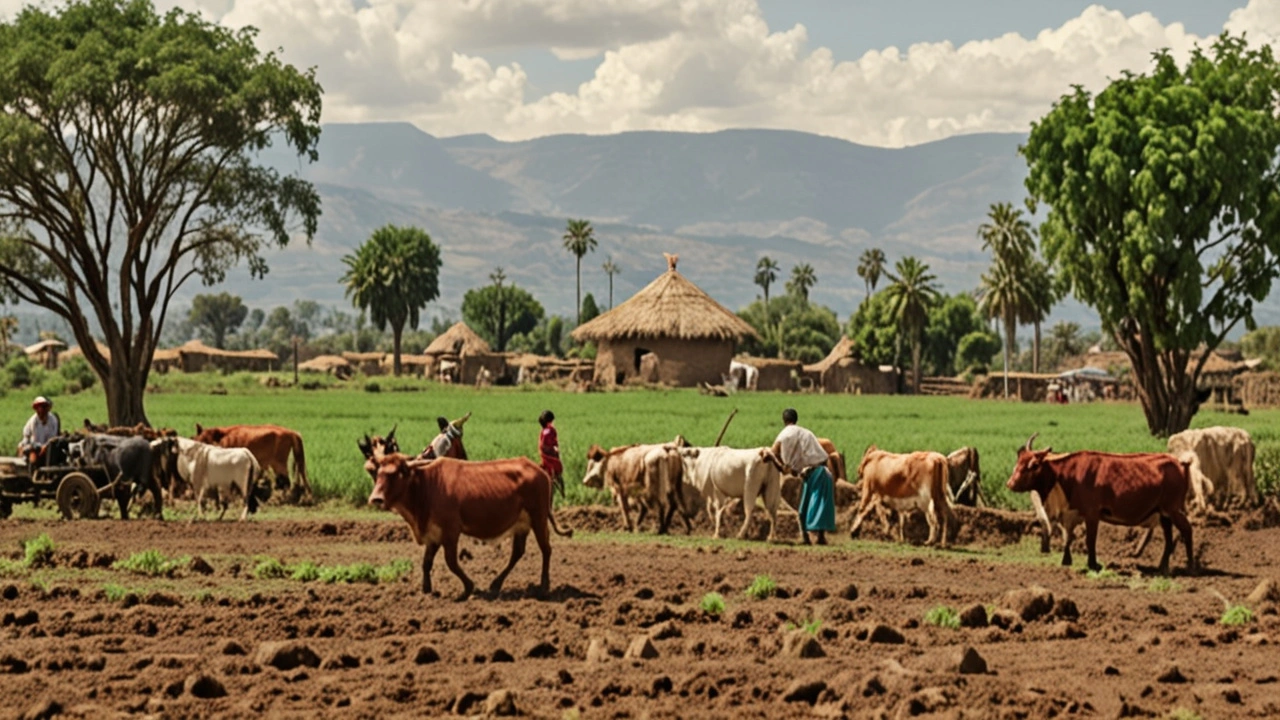Ethiopia, known for its diverse cultures and landscapes, has a deeply rooted agricultural heritage. The primary occupation for most Ethiopians, agriculture is the backbone of the country's economy and sustains the livelihoods of millions. This essential sector is not just about subsistence but also plays a crucial role in economic growth and development.
Historically, Ethiopian farmers have practiced diverse farming methods adapted to various climatic conditions, ranging from the fertile highlands to the arid lowlands. In recent years, there has been a shift towards modern farming techniques, although traditional practices remain prevalent.
- Introduction to Ethiopian Agriculture
- Historical Context
- Modern Farming Practices
- Challenges and Opportunities
- Impact on the Economy
- Future Prospects
Introduction to Ethiopian Agriculture
Imagine a land where nearly 80% of the population is engaged in farming activities – that's Ethiopia. Agriculture is the lifeline for millions, weaving through the fabric of daily life. Stretching across diverse climates and terrains, Ethiopia's agricultural sector is as varied as its topography, ranging from the lush highlands to the arid lowlands. This sector is pivotal, accounting for about 40% of the nation's GDP, reflecting its significant influence on the overall economy.
The story of Ethiopian agriculture is not new. It's an intricate mix of ancient traditions and emerging innovations. Ethiopia, often referred to as the birthplace of coffee, boasts some of the richest agricultural lands. Farmers grow everything from staple crops like teff, maize, and sorghum to coffee, which has a profound cultural and economic importance. A traditional Ethiopian meal might include injera, a flatbread made from teff, demonstrating the close connection between farming and daily sustenance.
A historical context reveals that agriculture has always been at the heart of Ethiopian civilization. Ancient terracing and irrigation techniques have allowed communities to thrive in challenging environments. Yet, while ancient methods persist, there is an increasing adaptation to modern techniques. Use of fertilizers, improved seeds, and mechanization are finding their way into the fields, particularly in more progressive regions.
Indeed, the agriculture sector in Ethiopia is teeming with potential. However, it faces significant challenges, including climate variability, limited access to modern inputs, and market accessibility issues. The Ethiopian government, along with various non-governmental organizations, is working towards alleviating these issues. The Growth and Transformation Plan (GTP), for instance, aims at transforming traditional farming into a more commercial, productivity-driven activity.
A quote from the World Bank points out, "Agricultural growth is the key to poverty reduction in Ethiopia,” highlighting the sector's importance. The government’s initiatives focus on enhancing productivity, ensuring food security, and increasing farmers' incomes. Improved infrastructure, better agricultural policies, and investment in rural areas are some of the strategic moves intended to invigorate this vital sector.
Furthermore, the agricultural calendar in Ethiopia revolves around two key rainy seasons - the Belg (short rains) from March to May and the Meher (long rains) from June to September. These seasons dictate cropping and harvesting patterns, influencing agricultural productivity and livelihoods. The reliance on rainfed agriculture means that any variability in climate can have profound impacts, making it crucial for farmers to be adaptive and resilient.
The future of Ethiopian agriculture looks promising, with increasing investments in agricultural research and development. Demonstrating extraordinary resilience and adaptability, Ethiopian farmers continue to sustain the nation's food supply. Whether through age-old traditions or embracing new technologies, agriculture remains an enduring pillar, deeply entwined with Ethiopia’s identity and future trajectory.
Historical Context
Ethiopia's rich history in agriculture dates back thousands of years. The country is often credited as one of the original birthplaces of agriculture, with archaeological evidence suggesting that farming activities in the region began as early as 5,000 BC. The ancient Ethiopians were among the first to domesticate a variety of crops, including teff, a highly nutritious grain that remains a staple in the Ethiopian diet today. The diverse climate, ranging from cool highlands to hot lowlands, allowed the cultivation of various crops and the development of sophisticated agricultural systems.
One compelling aspect of Ethiopia's agricultural history is the terraced farming in the northern highlands. These terraces, built to prevent soil erosion and conserve water, are an ingenious solution to the hilly terrain. The ancient terraces of Konso, designated as a UNESCO World Heritage site, are a testament to the ingenuity and adaptability of early Ethiopian farmers. This practice has persisted over the centuries and continues to influence modern farming techniques.
The introduction of coffee, Ethiopia's most famous export, is another critical milestone. Coffee cultivation began in the Kaffa region and expanded globally, becoming one of the world's most beloved beverages. Legend has it that a goat herder named Kaldi discovered coffee when he noticed his goats becoming particularly lively after eating berries from a certain tree. This discovery led to the establishment of coffee as a vital crop and economic driver.
During the ancient Axumite Kingdom, agriculture flourished with the support of advanced irrigation techniques and a well-organized system of trade that connected Ethiopia to the Arabian Peninsula, India, and beyond. This period saw an increase in crop diversity and improved farming methods, which laid the foundation for a thriving agricultural economy. The Axumite farmers cultivated grains, legumes, and a variety of fruits, which were critical for sustaining the population and fueling trade.
Throughout Ethiopia's history, agriculture has also been influenced by various external factors, including the arrival of European colonizers. While Ethiopia was never fully colonized, the brief Italian occupation in the 20th century did introduce some agricultural changes, including the introduction of new crops and farming techniques. However, traditional farming practices have largely persisted, demonstrating the resilience and continuity of Ethiopia's agricultural heritage.
In recent decades, the Ethiopian government and international organizations have worked to modernize agriculture while preserving traditional methods. Initiatives to improve irrigation, introduce high-yield crop varieties, and provide access to agricultural education have had significant impacts. Despite these advancements, many Ethiopian farmers continue to rely on age-old practices that have been passed down through generations, illustrating the deep cultural connection to the land and its cultivation.

Modern Farming Practices
Modern farming practices in Ethiopia have taken substantial strides in recent years, significantly transforming the agricultural landscape. The shift towards contemporary techniques has been propelled by the need to increase productivity and make farming more sustainable. Ethiopia’s government and numerous non-governmental organizations have been at the forefront, promoting innovations that promise a more robust agricultural sector.
One of the key changes in modern farming is the adoption of improved seed varieties. These seeds are engineered to withstand the varied climate of the region, offering enhanced yield and resilience. This innovation alone has skyrocketed productivity, allowing farmers to harvest more per hectare than ever before. Additionally, irrigation practices have seen a notable upgrade. Drip irrigation systems have been introduced to combat the unpredictability of rainfall, making water usage more efficient and crops more consistent.
Another crucial aspect of modern farming in Ethiopia is the use of fertilizers. The implementation of balanced and scientifically formulated fertilizers helps to address the nutrient deficiencies in the soil. This practice has not only increased crop yields but also improved the quality of the produce, making it more competitive in global markets. The introduction of mechanization in farming, including tractors and harvesters, has also lessened the physical burden on farmers and sped up various farming processes.
The Ethiopian government has also been investing heavily in agricultural research and development. New farming techniques are continually being explored and tested to ensure they are suitable for the unique Ethiopian farming context. One notable initiative is the Farmer Training Centers (FTCs) established across numerous regions. These centers provide invaluable training and resources to farmers, emphasizing the importance of modern techniques and innovations in farming.
Technology has become an indispensable part of Ethiopian agriculture. Mobile apps and other digital tools have started to play a crucial role in disseminating information and connecting farmers with markets. These platforms provide real-time data on weather forecasts, pest control methods, and market prices, enabling farmers to make informed decisions. One standout app, 'Agrinet', helps farmers find the best prices for their produce, ensuring better economic returns.
While these modern practices bring a lot of promise, they are not without challenges. Access to these innovations is still uneven, with many smallholder farmers finding it hard to afford the new technologies. Efforts are being made to address these barriers through subsidies and financial support schemes. Collaborative efforts between the government, private sector, and international bodies aim to bridge this gap and extend the reach of these transformative practices.
Ethiopian Prime Minister Abiy Ahmed once said, “Transforming our agriculture is key to achieving our national development goals. We must embrace modern techniques to uplift our farmers and ensure food security for all.”
Despite these challenges, the potential of modern farming practices in Ethiopia remains immense. With continued investment and innovation, Ethiopian agriculture is on a path to greater efficiency and sustainability. The impact of these changes is already visible, with increased production, better quality crops, and improved livelihoods for many farmers.
Impact on the Economy
Agriculture is the cornerstone of Ethiopia's economy, making up a significant portion of the country's GDP. Over 70% of Ethiopia's workforce is engaged in farming and related activities. This labor generates more than half of the nation's export revenues, largely through coffee, which is a major cash crop. Beyond coffee, Ethiopia produces teff, a unique cereal, which not only feeds millions but is also exported to countries with Ethiopian communities.
The agricultural sector's influence extends beyond just employment and production. It also has a huge ripple effect on other industries, including transport, trade, and finance. For instance, the transportation infrastructure has expanded primarily to facilitate the movement of agricultural products from rural areas to urban markets. This infrastructure development can, in turn, promote growth in other sectors like tourism and manufacturing.
A noteworthy aspect is the multifaceted nature of Ethiopia's agriculture. It's a blend of traditional and modern techniques that encapsulate the country's cultural heritage while also integrating advances in agricultural science. This combination is both a strength and a challenge. The use of traditional methods preserves biodiversity and maintains soil fertility, but it can also limit productivity when compared to modern practices.
One of the significant economic influences of agriculture in Ethiopia is its role in food security. With a large portion of the population relying on what they grow to feed their families, any shifts in agricultural productivity can have widespread repercussions. The government and various non-governmental organizations have been working on initiatives to improve yields through enhanced farming techniques and better access to resources like seeds and fertilizers.
Coffee, as mentioned, holds a place of particular importance. Ethiopia is often hailed as the birthplace of coffee, and the coffee industry supports millions of Ethiopians. The nation's diverse coffee varieties have made it a staple in the global market, contributing significantly to foreign exchange earnings. Similarly, livestock farming is an integral part of Ethiopia’s agricultural landscape, contributing to both GDP and the livelihoods of many rural families.
Despite its dominant role, Ethiopia’s agricultural sector faces several challenges, including climate change, land degradation, and pest infestations. These issues can severely impact productivity. The 2015-2016 drought, for instance, severely affected crop and livestock production, underscoring the vulnerability of Ethiopia's agriculture to climatic variations.
Yet, amidst these challenges are numerous opportunities. Technological advancements in irrigation, pest control, and crop breeding can significantly boost productivity. International collaborations and investments also hold promise. Organizations like the World Bank have been active in funding projects aimed at improving Ethiopia's agricultural infrastructure and practices. A quote from a World Bank report states:
"Ethiopia's agricultural sector is at a pivotal point where modern technology and traditional methods can coexist to create a robust, sustainable, and inclusive agricultural economy."
The future prospects for Ethiopian agriculture are promising, with focused efforts on sustainable practices and innovative approaches. The impact on the economy will likely remain substantial, driving forward not just economic growth but also social and cultural developments.

Future Prospects
Looking ahead, the future of agriculture in Ethiopia holds immense potential for transformation and growth. As the country strives to modernize its agricultural sector, several key factors will play a crucial role in shaping its trajectory. One of the primary areas of focus is on improving productivity through the adoption of advanced farming technologies. By investing in technologies such as precision farming, drone surveillance, and improved irrigation systems, Ethiopian farmers can significantly enhance their yield and reduce crop losses due to pests and diseases.
Another promising aspect lies in the promotion of crop diversification. Traditionally, Ethiopian agriculture has been dominated by staple crops such as teff, maize, and sorghum. However, there is now a growing emphasis on encouraging farmers to diversify their crops to include high-value cash crops like coffee, fruits, and vegetables. This shift not only boosts income for farmers but also strengthens the agricultural sector's resilience against adverse weather conditions and market fluctuations.
Addressing the challenges of climate change is also paramount for the future of Ethiopian agriculture. The unpredictable weather patterns and increasing frequency of droughts have placed significant strain on farmers. To counter this, there is a pressing need for climate-smart agriculture practices. This includes promoting sustainable land management, water conservation, and the use of drought-resistant crop varieties. By prioritizing environmental sustainability, Ethiopia can safeguard its agricultural resources for future generations.
Improving market access and value chains is another critical avenue for growth. Many Ethiopian farmers currently face difficulties in reaching larger markets and obtaining fair prices for their produce. Investments in infrastructure, such as rural roads and storage facilities, along with the development of efficient supply chains, can help farmers connect with national and international markets. This, in turn, can lead to increased profitability and economic stability within rural communities.
According to Dr. Ejigayehu Tefera, an agricultural economist at Addis Ababa University, "Investing in market access and infrastructure is vital for ensuring that Ethiopian farmers can compete on a global scale and secure better livelihoods."
Moreover, the role of education and training cannot be overstated. Empowering farmers with the knowledge and skills needed to adopt modern agricultural practices is essential for driving progress. Farmer training programs, extension services, and agricultural research institutions play a pivotal role in disseminating best practices and innovations to the farming community. By fostering a culture of continuous learning and improvement, Ethiopia can build a resilient and adaptive agricultural sector.
Finally, government policies and international collaborations will be instrumental in shaping the future of Ethiopian agriculture. Supportive policies that provide financial incentives, subsidies, and access to credit can encourage farmers to invest in modern agricultural techniques. Additionally, partnerships with international organizations and donor agencies can bring in much-needed expertise and resources to drive sustainable agricultural development.
In conclusion, the future prospects for agriculture in Ethiopia are promising, with significant opportunities for growth and transformation. By leveraging technology, promoting diversification, addressing climate challenges, improving market access, enhancing education, and enacting supportive policies, Ethiopia can unlock the full potential of its agricultural sector and pave the way for a prosperous future.

 Travel Safety in Ethiopia: Current Insights for 2024
Travel Safety in Ethiopia: Current Insights for 2024
 Comprehensive Guide to Rent Prices in Ethiopia (2024): Converting to USD
Comprehensive Guide to Rent Prices in Ethiopia (2024): Converting to USD
 Cost-Effective Business Startups: Discover the Cheapest African Nations
Cost-Effective Business Startups: Discover the Cheapest African Nations
 Discovering Ethiopia's Wealthiest: A Look at the Richest Person
Discovering Ethiopia's Wealthiest: A Look at the Richest Person
 Top High-Paying Jobs in Ethiopia in 2024
Top High-Paying Jobs in Ethiopia in 2024
love monster
July 11, 2024 AT 17:35Wow, the depth of Ethiopia's agri‑ecosystem is impressive – from teff genetics to high‑value coffee export pipelines. The sector's yield optimization potential is massive, especially with integrated pest‑management and precision agtech. I love how the narrative blends traditional terracing with modern irrigation, creating a robust value chain that can boost farmers' income. Keep an eye on the emerging seed‑technology hubs; they're engineering climate‑resilient varieties that could reshape the country's food security landscape. 🚀
Christian Barthelt
July 11, 2024 AT 18:42The article mistakenly says "agricultural heritage" when it should be "agricultural heritage," with the apostrophe placed after the "s" to denote plural possession. Also, the phrase "the backbone of the country's economy" is a cliché; a more precise term would be "the primary driver of GDP." Minor edits, but they improve clarity.
Ify Okocha
July 11, 2024 AT 19:40Ethiopia's reliance on rain‑fed agriculture is a textbook example of structural fragility, and the article glosses over the systemic risks. First, the sheer concentration of 80% of the workforce in a sector vulnerable to climate variability creates a massive shock absorber that is far too weak. Second, the lack of widespread mechanization means labor productivity remains low, perpetuating poverty cycles. Third, while modern seed varieties are mentioned, their distribution is uneven, favoring regions with better infrastructure. Fourth, fertilizer subsidy programs have been plagued by misallocation, leading to inefficiencies and environmental degradation. Fifth, the narrative underestimates the impact of land tenure insecurity on investment decisions. Sixth, market access remains limited by poor road networks, inflating transport costs and eroding profit margins. Seventh, extension services are overstretched, providing inadequate technical support to smallholders. Eighth, the reliance on coffee as a cash crop introduces commodity price volatility into rural incomes. Ninth, the absence of comprehensive insurance schemes leaves farmers exposed to drought and pest outbreaks. Tenth, water resource management is still rudimentary, with many irrigation projects underutilized. Eleventh, the demographic pressure from a growing population intensifies land scarcity. Twelfth, gender disparities persist, limiting women's access to inputs and credit. Thirteenth, the informal nature of many agricultural markets hampers data collection and policy formulation. Fourteenth, the article fails to address the potential of renewable energy integration in farming operations. Finally, without coordinated regional policies, these challenges will continue to constrain Ethiopia’s agricultural transformation.
William Anderson
July 11, 2024 AT 20:30That’s a lot to take in.
Sherri Gassaway
July 11, 2024 AT 21:12One might contemplate the philosophical paradox of progress: how can a society honor its ancient terraced wisdom while simultaneously sprinting toward hyper‑modernity? The equilibrium lies not in abandonment but in synthesis.
Milo Cado
July 11, 2024 AT 22:19Great overview! It's encouraging to see how Ethiopia is balancing tradition with innovation. The push for drip irrigation and mobile market apps could really empower smallholders. 🌱📱
MONA RAMIDI
July 11, 2024 AT 23:17Honestly, those drip systems sound fancy, but can the average farmer even afford them?
grace riehman
July 12, 2024 AT 00:07Hey folks, this post really shows how diverse Ethiopian farming is – from the highlands teff to the coffee beans. It's cool to see the country getting more support for its farmers.
Vinay Upadhyay
July 12, 2024 AT 00:49Interesting read, but let's be real: the "modern" techniques are often just repackaged old ideas. Some regions get the shiny toys, while others stay stuck with hand‑tools. The discrepancy is glaring, and the data doesn't lie.
Eve Alice Malik
July 12, 2024 AT 01:55I'm curious about how the new training centers are actually reaching the remote villages. Do they have enough staff?
Debbie Billingsley
July 12, 2024 AT 02:54America's agricultural policies should be the benchmark. Ethiopia must adopt stronger standards to truly compete globally.
Patrick Van den Berghe
July 12, 2024 AT 03:44Nice summary. Really nice.
Josephine Gardiner
July 12, 2024 AT 04:25Thank you for the concise synthesis. The articulation of Ethiopia’s agricultural trajectory is both comprehensive and precise, offering valuable insight for scholars and practitioners alike.
Jordan Fields
July 12, 2024 AT 05:32The piece could improve by citing specific yield statistics for teff and coffee.
Divyaa Patel
July 12, 2024 AT 06:30Yield numbers are the heartbeat of any agri‑story, and without them we’re just painting pictures. Let’s demand those figures!
Larry Keaton
July 12, 2024 AT 07:20Yo, this article nails the big picture but we gotta think about the micro‑level support – like actual financing schemes that reach the little farms.
Liliana Carranza
July 12, 2024 AT 08:02Absolutely! When farmers see real money in their pockets, they’ll be pumped to adopt new tech. Let’s keep the momentum going!
Jeff Byrd
July 12, 2024 AT 09:09Cool article, but I think we’re sugar‑coating the challenges. Real talk: without massive foreign aid, progress will be snail‑pace.
Joel Watson
July 12, 2024 AT 10:07While foreign investment can catalyze growth, it must be strategically aligned with local capacity building to avoid dependency.